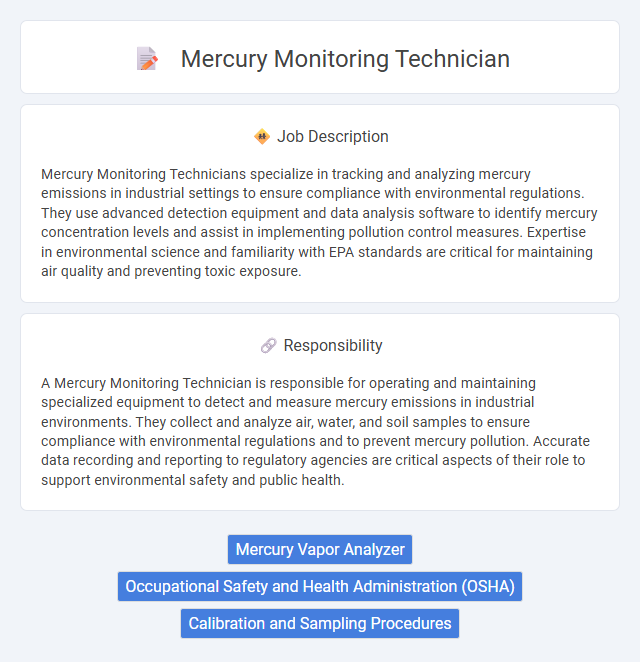
Mercury Monitoring Technicians specialize in tracking and analyzing mercury emissions in industrial settings to ensure compliance with environmental regulations. They use advanced detection equipment and data analysis software to identify mercury concentration levels and assist in implementing pollution control measures. Expertise in environmental science and familiarity with EPA standards are critical for maintaining air quality and preventing toxic exposure.
Individuals with a strong attention to detail and a background in environmental science or engineering may be suitable for a Mercury Monitoring Technician role. Those comfortable working in potentially hazardous environments and following strict safety protocols could likely adapt well to the job requirements. People with respiratory conditions or sensitivity to toxic substances might find this position challenging and less suitable.
Qualification
Mercury Monitoring Technicians require specialized training in environmental science or industrial technology, often holding certifications in hazardous materials handling or environmental monitoring. Proficiency with mercury detection equipment, such as atomic absorption spectrometers and cold vapor analyzers, is essential for accurate data collection and regulatory compliance. Strong knowledge of OSHA and EPA standards related to mercury exposure and safety protocols ensures effective risk management in industrial or laboratory settings.
Responsibility
A Mercury Monitoring Technician is responsible for operating and maintaining specialized equipment to detect and measure mercury emissions in industrial environments. They collect and analyze air, water, and soil samples to ensure compliance with environmental regulations and to prevent mercury pollution. Accurate data recording and reporting to regulatory agencies are critical aspects of their role to support environmental safety and public health.
Benefit
A Mercury Monitoring Technician position likely offers competitive benefits such as health insurance, retirement plans, and paid time off, enhancing overall job satisfaction. Employees might also gain specialized training and professional development opportunities to advance their careers in environmental science. These benefits could improve work-life balance and provide long-term financial security.
Challenge
The Mercury Monitoring Technician role likely presents challenges related to accurately detecting and measuring mercury emissions in various industrial environments, requiring precise calibration and maintenance of sensitive equipment. Complex regulatory requirements and the need to adapt to evolving environmental standards may further complicate the monitoring process. There is a probability that technicians must troubleshoot unexpected data anomalies and ensure continuous compliance under strict safety protocols.
Career Advancement
Mercury Monitoring Technicians gain specialized expertise in environmental regulations and hazardous material handling, positioning themselves for roles in environmental compliance and safety management. Mastery of advanced monitoring technologies and data analysis often leads to supervisory or technical specialist opportunities. Career advancement frequently includes certifications in environmental science, project management, and regulatory compliance, expanding prospects in industrial, governmental, and consulting sectors.
Key Terms
Mercury Vapor Analyzer
Mercury Monitoring Technicians specialize in detecting and quantifying mercury vapor levels using advanced Mercury Vapor Analyzers, ensuring compliance with environmental and occupational safety standards. Proficient in calibration and maintenance, they provide accurate, real-time data critical for industrial emissions monitoring and workplace safety assessments. Expertise in interpreting readings supports timely mitigation actions to prevent mercury exposure and contamination.
Occupational Safety and Health Administration (OSHA)
Mercury Monitoring Technicians ensure compliance with OSHA standards by accurately detecting and measuring mercury levels in industrial and environmental settings, minimizing health risks associated with mercury exposure. They implement OSHA-mandated safety protocols, including the use of personal protective equipment (PPE) and proper ventilation systems, to protect workers from toxic mercury vapors. Regular training on OSHA regulations and emergency response procedures is essential for maintaining workplace safety and preventing mercury-related occupational illnesses.
Calibration and Sampling Procedures
Mercury Monitoring Technicians perform precise calibration of mercury analyzers using certified standards to ensure accurate measurement accuracy. They conduct systematic sampling procedures involving the collection of air or water samples with specialized equipment to detect mercury concentrations effectively. Mastery of these calibration and sampling protocols is critical for compliance with environmental regulations and maintaining data integrity in mercury emissions monitoring.
 kuljobs.com
kuljobs.com